

UMSU and UWSU rally against provincial government for international student healthcare

Students and community members gathered outside of the Manitoba Legislative Building on Oct. 30 to call on the provincial government to reinstate healthcare coverage for international students, a promise they made that remains unfulfilled.
The rally, organized by UMSU and the University of Winnipeg Students’ Association (UWSA), aimed to remind the provincial government of international students’ struggle to accessible healthcare.
Noah Schulz, provincial director of the Manitoba Health Coalition (MHC), said the organization is committed to supporting students in their call for change.
“We’re a non-profit, non-partisan advocacy group
News 6
New cultural club
East African Students Association awaiting UMSU approval
Editorial 10
Inventing the wheel
In pottery, and all other things, you have to begin somewhere
Comment 12
All Hallow’s thieves
Why people were dressing up as the Louvre robbers for Halloween this year
calling for an improved and expanded public healthcare system and combatting healthcare privatization,” Schulz said. “I’m here to support the students.”
Schulz argued the government’s current approach is unfair. “Healthcare is a
A roaring success
Life of Pi staged by Royal Manitoba Theatre Centre until Nov. 8 Arts & Culture 18
human right,” he said. “It’s not a commodity. It should be, in a country that says we have universal healthcare, accessible to everyone who resides here.”
Cont’d p. 4 / It <
Sports 19
Bisons cede no sets
Bisons mens volleyball team wins both games 3-0 against Calgary Dinos
PHOTO BY ZULKIFL RAFAH / STAFF
Nafisa Al Lilo, staff


109 HELEN GLASS BUILDING UNIVERSITY OF MANITOBA WINNIPEG, MB THEMANITOBAN.COM | 204. 474. 6535
GENERAL INQUIRIES: ME@THEMANITOBAN.COM
CIRCULATION INQUIRIES:
MISSING OR INCOMPLETE PAPER?
EMAIL: DISTRIBUTION@THEMANITOBAN.COM
EDITOR-IN-CHIEF Mikaela Warkentin editor@themanitoban.com
BUSINESS MANAGER Alice Teufack accounts@themanitoban.com
BUSINESS SUPPORT MANAGER Joshua Herold ads@themanitoban.com
EDITORIAL
MANAGING EDITOR Peace Ifeanyi me@themanitoban.com
COPY EDITOR Eden Quiring copy@themanitoban.com
COPY ASSOCIATE Mursal Ghiyasi
NEWS EDITOR Jesse Brogan news@themanitoban.com
NEWS EDITOR Roy Albright Obah news@themanitoban.com
RESEARCH & TECHNOLOGY EDITOR Mansura Meghla research@themanitoban.com
COMMENT EDITOR Quinn Mayhew comment@themanitoban.com
ARTS & CULTURE EDITOR Boris Tsun Hang Leung arts@themanitoban.com
SPORTS EDITOR Abdul-Jalilu Ahmed sports@themanitoban.com
DESIGN
DESIGN EDITOR Deveney Jarrow design@themanitoban.com
DESIGN ASSOCIATE Patricia Sanque
GRAPHICS EDITOR Emma Gillich graphics@themanitoban.com
GRAPHICS ASSOCIATE Teegan Gillich
AUDIO AND VIDEO
AUDIO EDITOR Max Reid audio@themanitoban.com
PHOTO EDITOR Mike Thiessen photo@themanitoban.com
PHOTO ASSOCIATE Ebunoluwa Akinbo
VIDEO EDITOR Zulkifl Rafah video@themanitoban.com
DIGITAL MEDIA EDITOR Faisal Rahman social@themanitoban.com
SOCIAL MEDIA ASSOCIATE Paula Robles Andia
REPORTERS
NEWS Arifah Gheesah
NEWS Nafisa Al Lilo
RESEARCH & TECHNOLOGY Nawal Semir
COMMENT Thandeka Katsika
COMMENT Kyra Campbell
ARTS & CULTURE Carrington Dong
ARTS & CULTURE Jordan Anglin
SPORTS Faiyaz Chowdhury
SPORTS Israel Abejoye
VOLUNTEERS
VOLUNTEERS
Mohamed Soussi Gounni
interested in volunteering?
email me@themanitoban.com today!
The Manitoban is the official student newspaper of the University of Manitoba. It is published monthly during the summer and each week of regular classes during the academic year by the Manitoban Newspaper Publications Corporation.
The Manitoban is an independent and democratic student organization, open to participation from all students. It exists to serve its readers as students and citizens.
The Manitoban is a member of the Canadian University Press, and our journalistic standards can be found on the Manitoban’s website.
The newspaper’s primary mandate is to report fairly and objectively on issues and events of importance and interest to the students of the University of Manitoba, to provide an open forum for the free expression and exchange of opinions and ideas and to stimulate meaningful debate on issues that affect or would otherwise be of interest to the student body and/ or society in general. The Manitoban serves as a training ground for students interested in any aspect of journalism.
Students and other interested parties are invited to contribute to any section of the newspaper. Please contact the appropriate editor for submission guidelines.
The Manitoban reserves the right to edit all submissions and will not publish any material deemed by its Editorial Board to be discriminatory, racist, sexist, homophobic or transphobic, ableist or libellous.
Opinions expressed in letters and articles are solely those of the authors. Editorials in the Manitoban are signed and represent the opinions of the writer(s), not necessarily those of the Manitoban staff, Editorial Board or the publisher.
A “volunteer staff” member is defined as a person who has had three volunteer articles, photographs or pieces of art of reasonable length and/ or substance published in the current publishing year of the Manitoban
Any individual who qualifies as a volunteer staff member must be voted in by a majority vote at a Manitoban editorial board meeting. Elected representatives and non-students may be excluded from holding votes as volunteer staff members in accordance with the Manitoban Constitution.
All contents are ©2025 and may not be reprinted without the express written permission of the Editor-in-Chief.

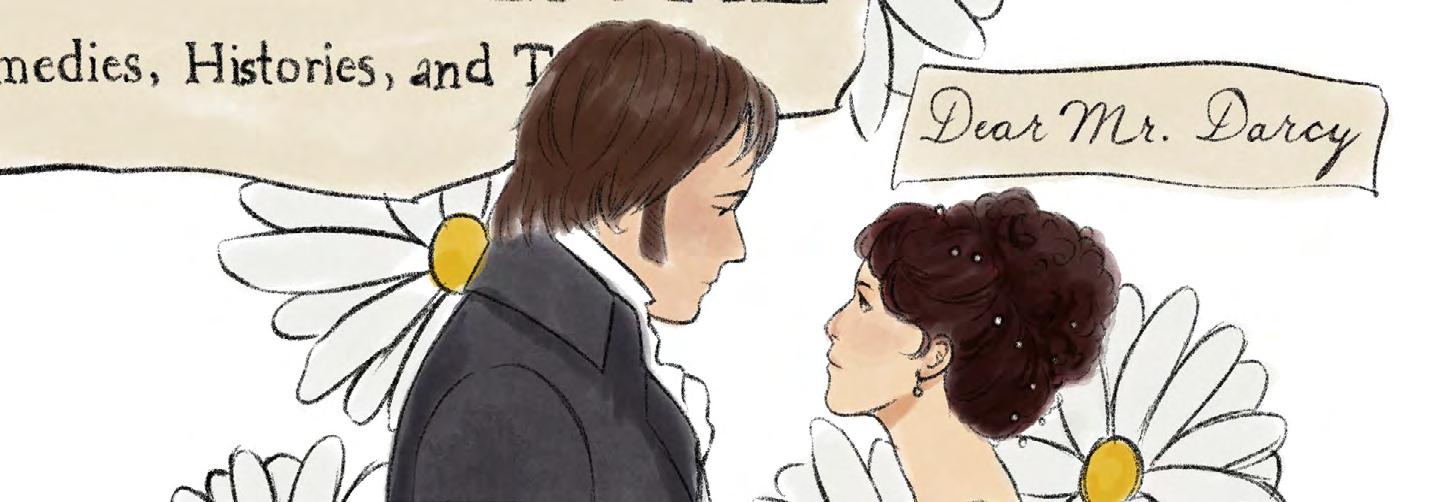
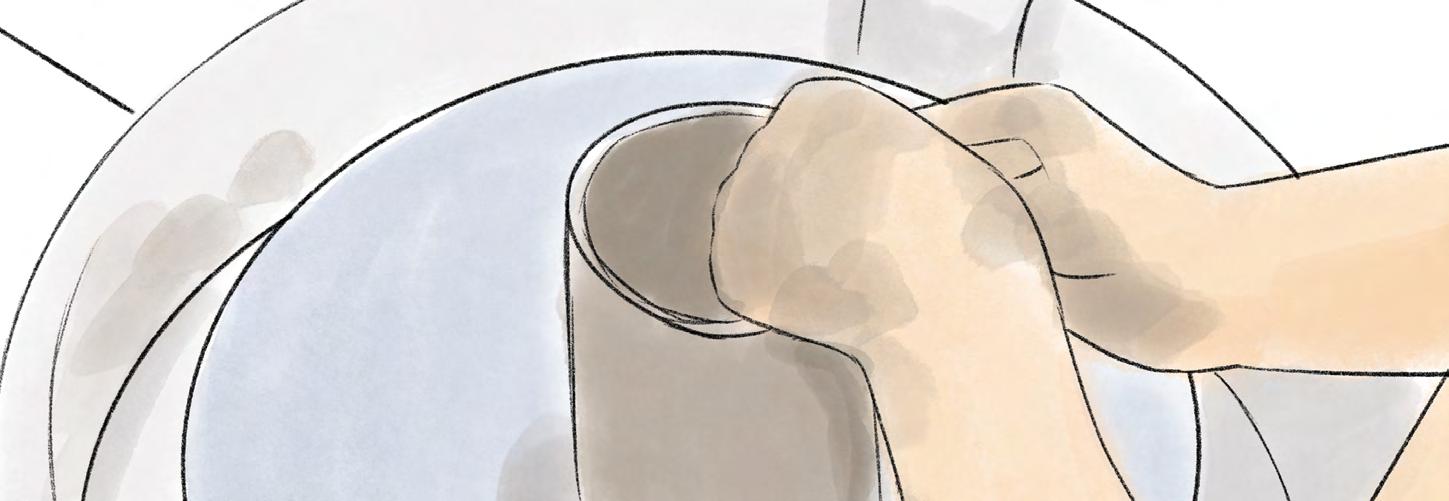
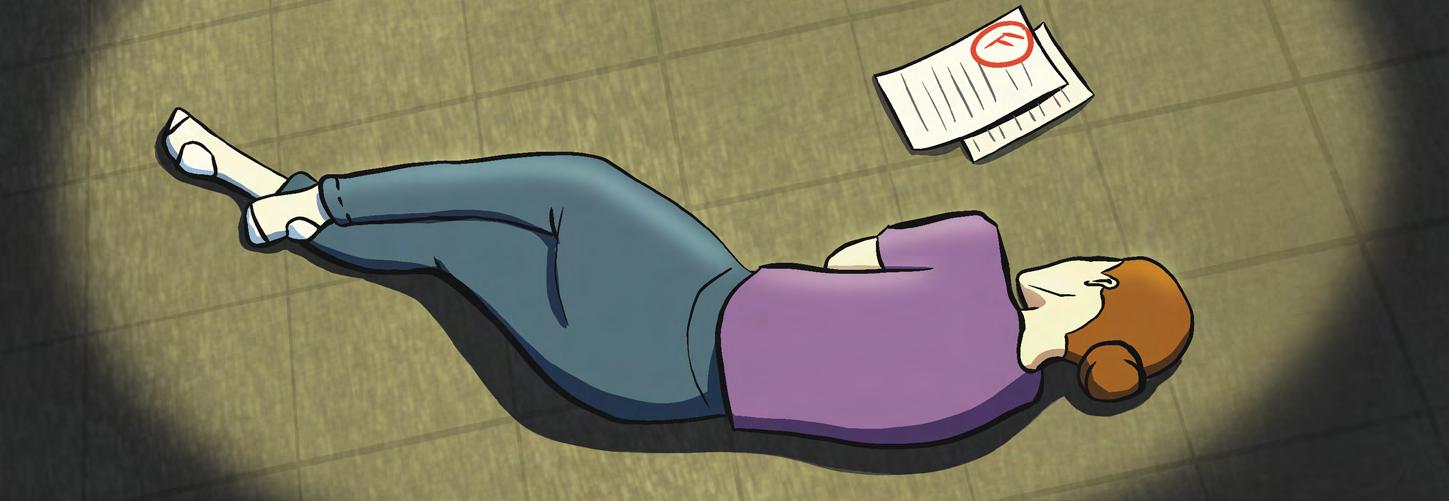

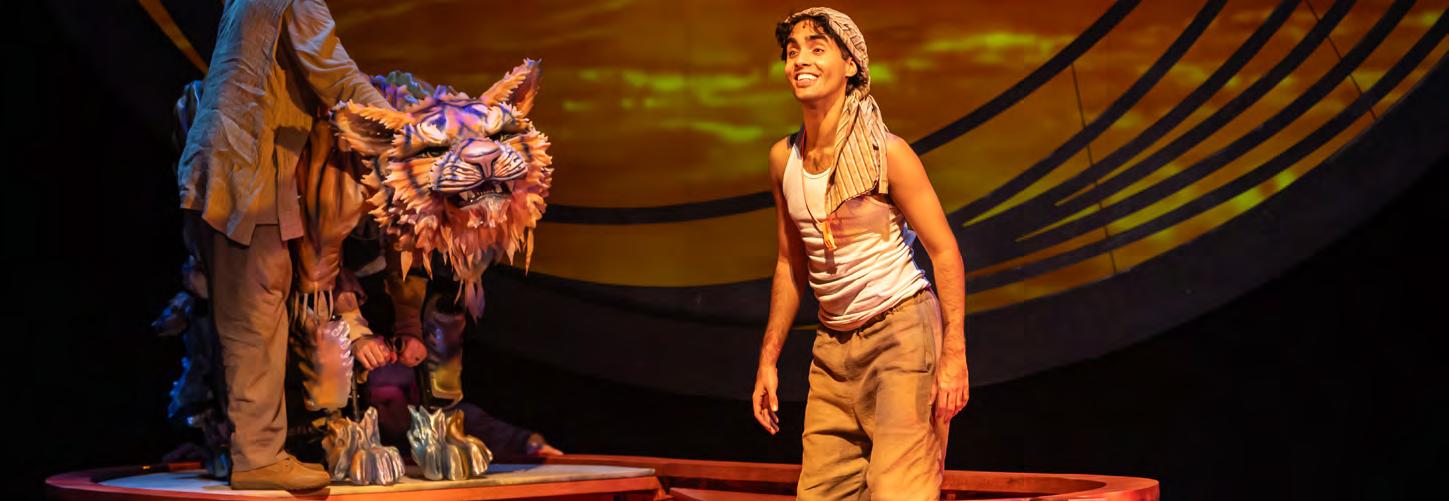

U of M security September 2025 report
Report shows changes in campus safety and security trends
Roy Albright obah, staff
The U of M Security Ser-
vices has released its September 2025 Monthly Report, providing an overview of incidents and safety activities across the Fort Garry and Bannatyne campuses. The report offers insights into community safety trends and the ongoing work of Security Services in ensuring a secure campus environment.
Medical emergencies rose notably from 16 cases September 2024 to 20 in September 2025. The report recorded 18 theft incidents this month at the Fort Garry campus and four at the Bannatyne campus, compared to about 30 cases last September.
Thefts in September 2025 involved nine personal items and seven bicycles, with a case of vehicular theft. Mischief reports, including graffiti and minor vandalism, totalled six this September, showing a reduction from 13 incidents recorded in September 2024.
New to this month’s report were three cases of hate propaganda discovered at UMSU University Centre, Fletcher Argue Building and Tier Building. Other reported incidents included one case

of fraud, seven City of Winnipeg bylaw infractions, two intoxicated persons and three traffic-related offences.
Security Services responded to 201 alarms, up from 191 last September, and processed 202 unscheduled
‘Toban news briefs
Jesse Brogan, staff
Late-night Winnipeg Transit
Winnipeg Transit plans to extend late-night service on 11 fixed routes starting in 2026, funded by $3 million in 2026 and $4.4 million in 2027. The proposal adds 33 staff positions and would permanently extend hours on 10 on-request routes to just before 2 a.m. from Monday through Saturday and 12:45 a.m. on Sundays and holidays. Winnipeg city council’s public works committee will vote this week to include the plan in next year’s budget.
Four-week residency at the Winnipeg Art GalleryQuamajuq
Nunavut’s Department of Culture and Heritage invites resident Nunavut Inuit visual and media artists to a four-week residency at WAG–Qaumajuq in 2026. The program offers studio and media equipment access for creating work, advising and promoting the Government of Nunavut’s Inuit art collection. Selected artists will receive $10,000, an expense allowance, accommodation, round-trip travel and materials.
access requests.
Security Services provide a range of programs and initiatives designed to enhance safety and support a positive campus experience for students, staff and visitors. These include the UM Safe app,
workshops, training sessions and educational programs.
The department’s primary goal is to ensure a secure environment where the U of M community can live, learn and work with confidence.
Staffed by licensed, full-
time security officers, the department offers 24/7 protection, maintaining a continuous presence across campuses.
City making changes to homeless encampments in November
Starting Nov. 17, Winnipeg will ban tents within 50 metres of playgrounds, splash pads, pools and daycares, and within 30 metres of transit shelters, bridges and docks. The policy follows an increase in the number of encampments, with last year’s count estimated at 2,500 people experiencing homelessness and about 100 camps housing up to 700 people. Enforcement will begin with outreach using existing staff. Fort Rouge–East Fort Garry Coun. Sherri Rollins said the rules may simply push people elsewhere.
Winnipeg launches parking plan and strategy
The City of Winnipeg released a five-year parking and mobility strategy to modernize how curbside spaces and parking are managed. The plan aims to improve convenience, accessibility and fairness through better signage and payment options, regular reviews of rates and hours and exploration of on-street EV charging. It will go to the Public Works committee on Nov. 6 before moving to executive policy committee and council for approval.
Winnipeg-wide compost program
Curbside compost collection is being planned for 2030. A new motion at City Hall asks Winnipeg’s public service to consider handling the work in-house rather than contracting it out. The motion detailed the costs, potential entry-level jobs for disadvantaged communities and savings from joint-equipment purchases with other cities. It also suggests aligning collector wages with garbage and recycling rates to control costs. The motion requires council approval. Currently, Winnipeg only offers compost drop-off zones.

PHOTO BY EBUNOLUWA AKINBO / STAFF
Weeks after UMSU’s protest, UWSA urges province to restore health coverage
< Cont’d from front page
“It also doesn’t make economic sense to exclude international students, who contribute hundreds of millions of dollars to our economy, when it only saves a few million to exclude them from this public system,” Schulz said.
Although the government has previously said it is committed to restoring healthcare coverage, Schulz said students have been waiting too long for concrete action. “The government continues to say they are committed to this, and that’s great to hear, but the students are […] past ready for a clear timeline and an action plan,” he said. “The NDP promised they would restore it while in opposition and on the campaign trail. They need to make good on that promise.”
Schulz added that students need to keep up pressure on the provincial government.
“Keep going […] We are not forgetting the promise that
the government made.”
The rally also drew support from domestic students who see access to healthcare as a broader issue. Among them was Ayesha Raza, UWSA community liaison director.
“Healthcare for all isn’t really an issue that’s divided for just international students,” Raza said. “It’s a promise that our government made.”
Raza explained that all members of the UWSA board contributed to the event through participation, collaboration and solidarity. “I want to show that this fight isn’t just international students demanding healthcare,” she explained. “We have [MHC and] domestic students here who understand this is an issue that’s widespread across our province and affects everyone in
some kind of way.”
Raza said she would tell the government officials that the time for waiting has passed.
“You made a promise, and it’s time to deliver,” she said. “I know bureaucratic matters are not always the easiest to tackle, but, that being said, if it is an issue, frankly, that you could not 100 per cent deliver
those promises today.”
Omega Budhathoki, UWSA vice president of external affairs, said the rally was part of ongoing efforts to hold the Manitoba government accountable.
“[Healthcare] should be, in a country that says we have universal healthcare, accessible to everyone who resides here”
— Noah Schulz, provincial director of the Manitoba Health Coalition
on then there was no reason to make a promise.”
She added that transparency is essential. “There’s also a lack of transparency,” Raza said. “I would like at least a bit of clarity when it comes to international student healthcare, as well as explaining how they’re going to be delivering


“We are still following through on the promise that Premier Wab Kinew made for international students on reinstating [their] healthcare after it was taken away by the PC government in 2018,” Budhathoki said. “They have been in office for half the term, and there has been no update, no timelines on how that [is] to be achieved.”
Budhathoki said costs for students are rising while healthcare remains out of reach. “Every year the premiums keep increasing,” she said. “It increased by 8.6 [per
cent] this year, and those are mandatory insurance premiums. You have to get extended coverage on top of it, and it’s not looking good for students.”
As an international student herself, Budhathoki explained she has seen how the lack of public healthcare affects the community. “This has created a two-tiered system where healthcare is really hard to access, even though students are paying expensive amounts of money for premiums,” she said. “This has affected well-being in very grave ways. We have lost people [in our] communities [and] more students are struggling with their […] education.”
Budhathoki encouraged students to continue speaking out. “If you […] feel like you’re not supported, you don’t have a voice, you do,” she said. “We are out here trying to bring awareness [and] fight for what is right.”
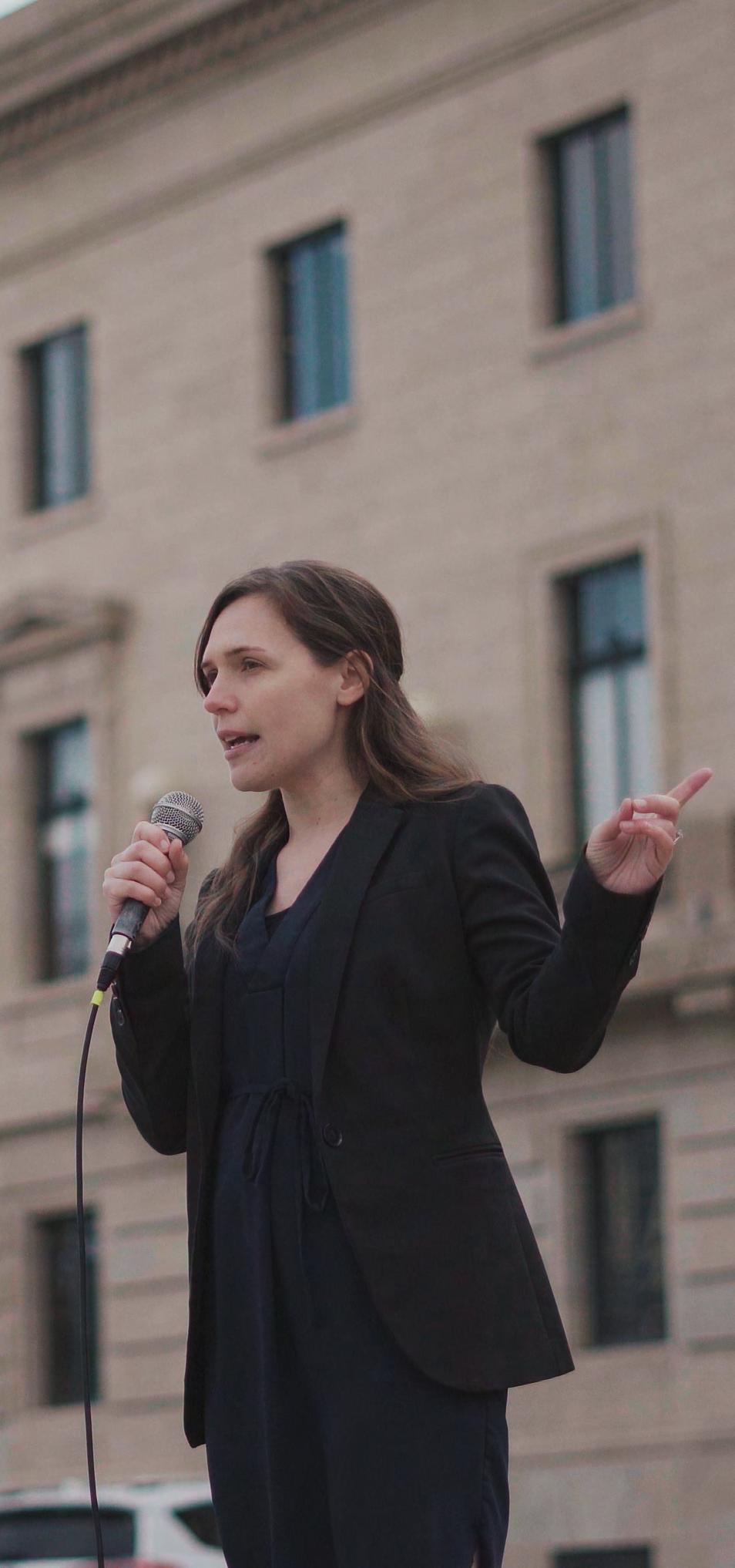
PHOTOS BY ZULKIFL
CIPA hosting first Winnipeg event
Event showcases training and support for immigrant professionals
Roy Albright Obah, staff
he Canadian Immi-
Tgrant Professional Alliance (CIPA) is set to host its first event in Winnipeg on Wednesday, Nov. 12, marking a milestone for immigrant-led professional empowerment in Canada.
The event will take place at the Roundhouse Auditorium, Red River College Polytech and bring together immigrant professionals, students, community leaders and employers to explore career pathways and inclusive workforce strategies.
Juanita Ama DeSouza-Huletey, founder, president and CEO of CIPA, said the organization was born out of experience and the conviction that immigrants can “come together to build something sustainable from within their own strength.” She emphasized collaboration forms the foundation of CIPA’s operations. The organization works with universities, employers and community agencies to align efforts and maximize impact.
Its programs align with several UN Sustainable Development Goals, including those focused on partnerships, decent work and innovation, aiming to bridge the gap between settlement and professional success.
CIPA integrates coaching, mentorship, digital training and social wellness into a single ecosystem. Through its coaching & mentorship hub, immigrant professionals receive guidance from mentors who understand cultural and professional transitions.
A key part of CIPA’s vision is empowering young immigrant and international stu-

dents to transition successfully into Canada’s workforce. The organization partners with institutions such as the University of Winnipeg and RRC Polytech to offer mentorship, internships and digital training.
“Students are at the heart of what we do,” DeSouza-Huletey said. “Integration must begin long before graduation.”
Beyond professional development, CIPA believes “true integration extends beyond employment,” DeSouza-Huletey noted. Workshops on mental health, parenting and community-building reinforce that “professional success is sustained
by personal and community well-being.”
“CIPA doesn’t aim to duplicate” DeSouza-Huletey added. “We exist to strengthen what already works […] We are immigrant-led and lived experience-driven, founded and powered by professionals who have personally navigated Canada’s social, cultural and professional systems,” she said.
CIPA’s framework is built on “the Five Cs,” which are coaching, connecting, collaborating, catalyzing change, and cultivating community. Its programs combine mentorship, digital training and social support, provid-
ing immigrants with resources that extend beyond settlement to long-term career success.
The Winnipeg launch event will showcase these programs, offering attendees opportunities to connect with partner organizations and access resources that support both professional and community integration.
DeSouza-Huletey said the goal is for CIPA to become “a national model for partnership-driven integration, where collaboration replaces competition, where every talent is recognized and where every immigrant professional can say with confidence, ‘I
belong. I am contributing. I am thriving.’”
She added the launch event will mark a “true celebration of collaboration, courage and community,” before moving toward the next phase — securing funding to sustain its growing ecosystem.
DeSouza-Huletey advised “Don’t give up on your dream. Your skills, your story, your accent, your experience — they are valuable, even if they aren’t always recognized right away.”
For more information and to participate in CIPA’s launch event, visit luma.com/3b6ey6wc.

PHOTO PROVIDED BY JUANITA DESOUZA-HUTELEY
Bisons players’ cars vandalized on campus
Reports of vandalism spark security review from students
Arifah Gheesah, staff
Eight members of the U of M Bisons soccer team returned from a weekend game in Saskatchewan to find their vehicles vandalized near the university’s outdoor soccer field.
The incident occurred on Friday, Oct. 21, when the players parked their cars in a U of M parking lot before leaving for the weekend. Upon their return on Sunday, they discovered that eight vehicles had been damaged, with windows smashed and personal belongings stolen.
The U of M did not notify the families or affected students about the incident. Adding to the concern, there was reportedly no security camera coverage in the area where the vandalism occurred. The investigation is now with the Winnipeg Police.
In September, a vehicle theft was reported on the U of M’s Fort Garry campus, raising concerns about security in campus parking lots. The incident adds to broader worries about vehicle-related crimes
in Winnipeg. According to the Winnipeg Police Service, 2,292 vehicle thefts were reported citywide between January and August this year. Students say they hope the university will strengthen safety measures to better protect both them and their vehicles.
Aryan Fida Nur, who typically parks after 4:30 p.m. on weekdays in Parking Lot J near the Architecture 2 Building, said he generally feels safe parking his car on campus. However, after hearing about the recent incident, he admitted to feeling less confident about leaving his vehicle unattended.
“I don’t think I can feel safe to park at night,” Nur said, adding that since there are fewer people on campus during the evenings, the university should do more to strengthen security measures.
Maham Shafique, who takes the bus to campus, said she also generally feels safe and often sees security cars around. Despite that, she mentioned she would not feel safe during winter at night.
“They do have a security safety app. I think they should promote that more,” Shafique said, adding that she only heard about the app through her employer rather than directly from the university.
Faisal Faisal, who parks on campus, said he usually sees campus security at night and believes their presence is reassuring. Still, he suggested the university should pay closer attention to students’ concerns regarding safety. He added after hearing about the recent break-ins, he no longer feels comfortable leaving his car overnight on campus.
As of now, the U of M has not issued a statement to students about the specific vandalism or confirmed whether new security measures will be implemented.
The university’s UM Safe app is designed to help students access safety resources and contact campus security, and it includes features such as walk-home options and emergency alerts

East African Students Association coming soon
New U of M club to celebrate East African culture awaits UMSU approval
Nafisa Al Lilo, staff
A new student organization is forming at the U of M to provide a space for East African Students and anyone interested in learning about the region’s cultures. The East African Students Association (EASA) has submitted its application to UMSU and is currently waiting for official recognition.
The club was the idea of sisters Rania Ibrahim and Efrah Ibrahim, who wanted an avenue for East African students to connect and explore their heritage. “We just wanted a space for East Africans to learn more about their heritage and get involved [on] campus,” Rania Ibrahim said.
The club’s secretary, Nafisa Hassan, mentioned the club is open to all students, not just those from East Africa. Hassan explained that many people are unfamiliar with the smaller countries of the region. “When they think of Africa, they think of the big countries, and we forget about
the little ones,” she said. “We would like people to know [about them] because they are beautiful countries, and the culture is very rich, and we would like people to be immersed in it.”
For many international students, the club can offer a sense of home on campus. Hassan said, “A community like this […] is so important, because [it gives me] a sense of home that I lack here.”
Outreach executive Ikram Imam said the club also serves students who may not have grown up in East Africa but want to connect with the culture. “Being able to gain something through our events […] it’s just a way to understand peers better,” she said.
Head of events Taqua Shapan said the club plans to
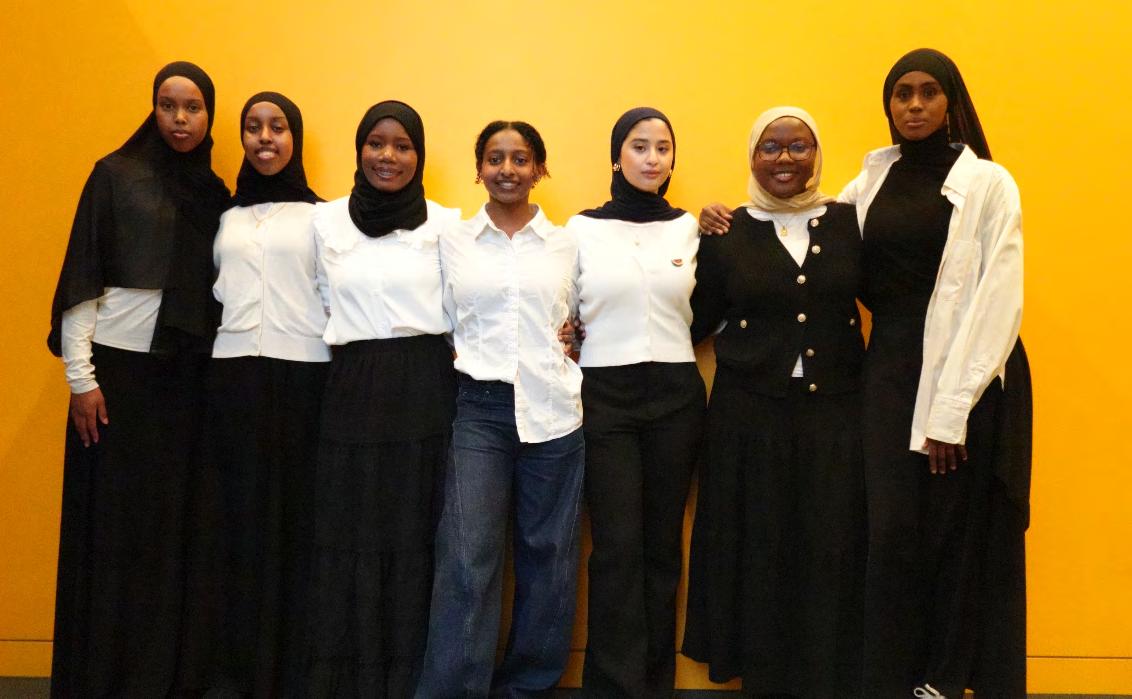
“I’m an international student, and a community like this that is being created is so important, because it’s like a sense of home that I lack here”
— Nafisa Hassan, Secretary of Upcoming East African Student’s Association.
host interactive cultural activ-
ities to teach students about East African traditions.
“Having game nights [...] like Kahoot! [with] questionnaires about different countries, cultures and traditions […] can [make this] a learning space for people who
aren’t East African,” she said.
Media executive Zahra Lokwa highlighted the club’s goal of sharing East African cultures with the broader campus community. “Most of our events will be university-based,” she said, including that the club is a strictly cultural initiative, welcoming all students regardless of race or religion.
While Rania and Efrah Ibrahim are the original
founders, Rania stressed “everyone on the executive team had a crucial role [in] bringing this idea to life.”
With its UMSU application awaiting approval, the EASA already has a clear vision to build community, celebrate culture and create opportunities for students from all backgrounds to connect, learn and share in a space that embraces East African cultures.
PHOTO BY EBUNOLUWA AKINBO / STAFF
PHOTO PROVIDED BY EAST AFRICAN STUDENTS ASSOCIATION


Research & Technology
Finding power in words
Exploring language, control and community through
Mansura Akter Meghla, staff
Erin Weinberg, an instructor II in the U of M department of English, theatre, film and media, spends her days exploring how stories from different eras reveal enduring questions about language, power and identity. Her work bridges classic texts by authors like William Shakespeare and Jane Austen with broader conversations that continue to shape how we understand the world today.
“I’m a Renaissance drama scholar by training, and my secondary research field is Jane Austen,” Weinberg said. “Lucky me, I get to read all the time!”
Weinberg’s academic journey reflects both curiosity and range. According to her, being an instructor allows her to explore a variety of interests from early modern theatre to crime fiction. “I pursue anything related to English literature that interests me,” she said. “Sometimes it’s Shakespeare, sometimes it’s Austen,” she added. Her recent conference paper focused on “Jane Austen and engagements,” which argued the period between engagement and marriage is a time of instability rather than triumph. Weinberg argued that Austen’s heroines often find themselves in a vulnerable position during this liminal phase, when their futures are still uncertain.
Weinberg’s work often returns to questions of power. “My research, as well as my teaching, tends to circle back to power dynamics,” she said. “Who has power, who wants power and what a person or group is willing to do to achieve that power.” Her work also focuses on how wealth, class, gender and ability influence who holds power, why certain voices carry more weight and the challenges of speaking truth to that power.
Beyond Austen and Shakespeare, Weinberg’s research also engages with how language can be used as a tool of control. She studies memoirs by people who have escaped cults and coercive groups, analyzing how leaders manipulate meaning to maintain dominance. “While words don’t have any physical dimension, the value systems behind [them] can be more restrictive than handcuffs or an electric fence,” she said. “Cult leaders redefine words in order to control members, and a significant part of deconstruction from a cult […] is redefining those words outside the context of damna-
literature

tion.”
Weinberg’s fascination with language extends into the classroom. Earlier this year, she caught international attention after a tweet about using Taylor Swift’s album
The Tortured Poets Department to teach grammar went viral, earning her an interview with The New York Times. “Is it a department of tortured poets or for tortured poets?” she asked. “This was a great opportunity to use current events as a teachable moment.”
see literature as something that reflects lived experience. In her “Literature and Food” course, Weinberg uses food
with scholars across disciplines to explore how food connects people and ideas.
“While words don’t have any physical dimension, the value systems behind [them] can be more restrictive than handcuffs or an electric fence”
— Erin Weinberg, instructor II in the U of M department of English, theatre, film and media
“It’s immensely inspiring,” she said. “I can’t tell you what a joy it is to spend time eating with other food lovers from across disciplines!”
have power” and literature is never just about words on a page.
Her teaching philosophy, like her research, emphasizes connection and creativity. She often encourages students to
as a lens for exploring themes of community, identity and survival. “Food isn’t just the stuff that we consume — it’s a symbol of community and identity,” she explained. As a member of the Food Matters Research Cluster at the U of M Institute for the Humanities, Weinberg collaborates
Looking ahead, Weinberg is studying how victims are portrayed in Agatha Christie’s The Body in the Library. She is examining how language and perspective can shift sympathy away from the victim to other characters. Her approach of blending close reading with questions of ethics and voice demonstrates her belief that “words
Special note from Erin Weinberg — “I’d like to remember Dr. Refaat Alareer. He was a university professor at the Islamic University of Gaza and a fellow scholar of Renaissance literature. The Israeli Occupation Forces demolished his entire university on Oct. 10, 2023. They targeted Dr. Alareer and bombed the building where he was sheltering, killing him, his siblings and his siblings’ children. Dr. Alareer spent his life harnessing the power of words to maintain hope, and the targeted nature of his murder and the demolition of his entire university shows just how powerful words, verse and education can be.”
GRAPHIC BY EMMA GILLICH / STAFF
Critical theory’s critique of judicial appointments
Professor emeritus visits Robson Hall for the Distinguished Visitors Lecture Series
Richard Devlin, professor emeritus at the Dalhousie University Schulich school of law, brought his expertise to the Robson Hall Distinguished Visitors Lecture Series on Oct. 25, challenging faculty and staff to rethink the foundations of the legal profession. Devlin’s lecture, “Glimpses of a Critical Theory of Canadian Law,” synthesized his 40 years of research, critically analyzing the judiciary and the judicial appointment process.
Drawing from the work of the Honourable Murray Sinclair, Devlin started the lecture by outlining how a person’s social context impacts their understanding of law. Devlin grew up in Belfast during the ’70s and ’80s, a time of great discrimination against Irish people, supported by both the British Parliament and celebrated common law judges such as Lord Denning, Lord Diplock and Lord Scarman. Shaped by the state violence and colonization of his youth, Devlin was drawn, during law and graduate school, to critical theorists whose conceptions of law mirrored his own experiences.
adjudicators, but rather normal people with their own thoughts and opinions.
According to Devlin, when judges construct ideas of the rule of law, the result reflects their own worldviews. Devlin argued, “Most critical theorists have strong reconstructive aspirations, programs and proposals.”
Using critical theory as a backdrop, Devlin mapped out the ongoing failures inherent in the Canadian judicial appointment process he has observed and reported on in the last few decades.
Devlin described the appointment process for federally appointed judges as an “executive failure.” On this matter, he co-authored an article titled, “Reducing the Democratic Deficit: Representation on Diversity in the Canadian Judiciary.” The 25-year-old paper argued, as Devlin explained, “that the Canadian judiciary [at the time] was hegemonically white and male.” The paper further noted that “the ultimate decision in the employ-

“Most critical theorists have strong reconstructive aspirations, programs and proposals”
— Richard Devlin, professor emeritus at the Dalhousie University Schulich school of law
Devlin explained that critical theory “is an intervention and ongoing conversation on the nature of law and the function of law,” with its main focus being on the relationship between law and power. According to critical theory, the judiciary is a political institution and judges serve as political actors. This theory posits that law is inherently indeterminate, allowing for significant judicial discretion. Devlin explained that judges are not impartial
ment process lay either with the minister of justice or the prime minister,” adding that these appointments “tended to correspond with the political ideologies of the government in power.”
To remedy this issue, Devlin and his co-authors suggested “independent judicial appointment commissions across the country [to] ensure judges were impartial, independent and purportedly representative.”
In 2016, Devlin and his co-author Adam Dodek, full professor and former dean at the University of Ottawa faculty of law, published their book, Regulating Judges: Beyond Independence and Accountability, introducing accountability, transparency and efficiency as important principles to consider in the appointment process. Devlin explained that this work constructed “an alternative narrative [beyond] just independence and impartiality,” building off the criticisms in his earlier work.
Devlin wrote another article on this topic in 2017 for a conference in South Africa titled “Dirty Laundry.” This piece examined Canadian judicial appointments under
the Stephen Harper government, finding that every judge appointed in Nova Scotia at the time was a personal friend of the minister of justice. Implementing the principles highlighted in his previous works, Devlin concluded that “independence was called into question, accountability was located exclusively in the executive, transparency was negligible, representativeness was very much a work in progress and efficiency was questionable.”
Devlin’s latest piece on the subject, “Trudeau’s Judicial Appointments: Good Looks Will Only Get You So Far,” was published in 2024. He argued significant issues persisted within the appointment process. “While there had been significant [...] progress in terms of diversity in the judiciary, many of the other values remain underdeveloped,” he explained. “In fact, things got so bad in terms of the appoint-
ment process, there were about 60 or 70 unfilled judicial vacancies.” It was discovered that this delay resulted from the minister of justice’s office rigorously vetting candidates for their political credentials. For Devlin, this is indicative of a still underdeveloped and failed process.
Devlin’s lecture also examined the failures in judicial discipline, judicial reconstruction and the dangers inherent in the self-regulation of the legal profession. Ultimately, this lecture served as a call to action, urging legal professionals and scholars to move beyond complacency and actively reimagine a legal system grounded in genuine accountability, substantive diversity and a critical awareness of its own political nature.
His lifelong work demonstrates that understanding the law’s relationship with power is the first and most necessary step toward transforming it.

PHOTO BY EBUNOLUWA AKINBO / STAFF
Nawal Semir, staff
The gift of being a beginner
On the path of learning, the first step is the most important
Emma Gillich, staff
As someone who works with clay, I can confidently say that learning how to wheel-throw was a humbling experience. I was sitting in a classroom surrounded by other nervous students, all sitting at the wheel, our professor having just finished effortlessly throwing a cylinder. Needless to say, none of ours went as smoothly. At the end of the class, I had a wobbly clay-thing that sort of resembled a deflated bowl. Covered in clay, my arms and back aching, I saw the challenge in front of me — I was supposed to make 40 cylinders, each
15 centimetres tall. That felt quite impossible at the time.
I spent hours in the studio each week, making cylinder after cylinder until finally the day came when I presented what I had accomplished to my professor. They weren’t perfect, some of them weren’t tall enough or didn’t have even walls, but all I saw was my progress. At the end of that project, I chose my best attempts, fired and glazed them, and proudly displayed them on my shelf. As for the rest, I had the cathartic experience of smashing them into pieces to reclaim them as clay and begin again.
It was a whirlwind of learning, with long days and more failures. Some days I wanted to quit, other days I felt so much triumph in having a single completed work to show. It is a humbling experience to dedicate an immense amount of time to learning something, to commit to being a beginner.
As I progressed, my own standards became harsher. I no longer felt pride at merely the completion of a competent work — instead I felt as though it was an expectation. On the days of continuous failure, I felt the aches from my long hours hunched over the wheel even sharper. I had lost
the charming feeling of being a beginner, and I scoffed at my early attempts.
This was until one day, my professor talked about how she still had her first pieces of pottery. Suddenly, it clicked. If someone at her level still spoke about her first works with pride, why didn’t I? If I had never been a beginner, I would never have gotten to where I am now. Those early attempts mark the start of my journey — they are stepping stones, they show my levels of experience.
This is why I now embrace each new challenge with open arms. If it takes me days or
weeks to master a new technique, I know that the eventual success will be even sweeter. I stand atop a mountain of failures and proudly add more to my collection. Each day comes with its own hardships. Often, I have to remind myself after a difficult day that trying makes me better than yesterday, and that there’s nothing wrong with having another go tomorrow. I may never be the beginner pottery artist with wobbly cylinders that I was, but I will always cherish the fact that I was her, and that she committed to not giving up.

GRAPHIC BY EMMA GILLICH / STAFF
Winnipeg’s Kimberly Prost deserves better than our silence
Canadian judge sanctioned by U.S. government for seeking truth and accountability
Mohamed Soussi Gounni, volunteer
One of our own has been caught in the crossfire of the Trump administration’s assault on the world order. Yet the responses from our administrators at Robson Hall, let alone from Ottawa, have been disappointing to say the least. I am speaking, of course, about the Honourable Kimberly Prost.
Judge Prost’s story began in Winnipeg’s Fort Rouge neighbourhood, where she was raised by a homemaker mother and a father who worked as both a brewery employee and hotel owner. She attended St. Mary’s Academy before enrolling at the U of M, graduating in 1981 as a gold medalist from the faculty of law.
Her first job out of law
school was with the Canadian Department of Justice (DOJ), working in the Winnipeg regional office as a federal prosecutor. By 1987, she had joined the DOJ’s Crimes against Humanity and War Crimes Unit in Ottawa, later becoming director of the International Assistance Group. In that role, she negotiated more than 40 bilateral extradition and mutual legal assistance treaties on Canada’s behalf, while also helping shape the Rome Statute that would establish the International Criminal Court (ICC).
After serving as chef de cabinet to the president of the court, she was elected as a judge of the ICC in 2017 — only the second Canadian ever to hold that position.
Her current work is in
Afghanistan, investigating possible war crimes by the U.S. government — vital work that should command attention from anyone who believes in truth and accountability.
How did the American government respond? With sanctions, of course — a Canadian judge, a Manitoban, a Winnipegger and U of M alumna has been punished for seeking the truth, and the best Prime Minister Mark Carney’s office can muster is a response from Foreign Minister Anita Anand, who said, “I have the utmost confidence in Judge Prost.”
Meanwhile, the U of M and Robson Hall have stayed silent — even the University of Ottawa has weighed in. Canada, as a middle power, thrives in a liberal, multilateral world order where the
rule of law is paramount. Yet today, our prime minister appears to be focused more on chasing trade deals than defending the principles that sustain us.
The U.S. government, the alleged “leader of the free world,” has shown open contempt for those same principles, as the Trump administration cuts the U.S. Agency for International Development, imposes tariffs on allies and partners, sanctions foreign courts, pulls vital lifesaving intelligence from Ukraine, blindly backs Israel regardless of consequence and even cuts off military assistance to European allies.
Against this backdrop, Canada’s silence in the face of unjust U.S. sanctions on one of our own shows a level of
cowardice that astounds me. I find it unbelieve that we would leave a Canadian high and dry like that. I understand that Canadians are not known to be confrontational, but how many punches to the gut will we take before Canada makes a principled stand against a bully?
Judge Prost’s career should be a source of pride for every student, Manitoban and Canadian. Instead, it has become a case study in institutional cowardice. If someone of her stature and prestige can be sacrificed in the name of not antagonizing our “closest ally,” what hope is there that this government will stand up for you?

Fitting in nowhere
Failing to belong is its own quiet kind of belonging
Quinn Mayhew, staff
W
hy is it so difficult for me to start things?
Am I a failure? I have always grappled with these questions, and they haunt me to this day. I hate starting things, and I think it’s because I fear failure — I think that everything I touch isn’t good enough, including this article.
I have noticed a lot of pretending — pretending to be fine, pretending that things aren’t wrong. I’m not just talking about myself, but about the things I notice in other people. I observe people, I watch to see if I can see a bit of myself in them. Do they also think they’re failing at life?
I often pretend I’m okay. Whether that’s at school, work or in friendships, I always feel like I’m falling somewhere between not being good enough and never trying my best at anything.
A quote from The Bell Jar by Sylvia Plath has always resonated with me. Plath writes about how each fig on a fig tree represents a different possible future. “I saw
myself sitting in the crotch of this fig tree, starving to death, just because I couldn’t make up my mind which of the figs I would choose. I wanted each and every one of them, but choosing one meant losing all the rest, and, as I sat there, unable to decide, the figs began to wrinkle and go black, and, one by one, they plopped to the ground at my feet.”
Despite being an active member in extracurricular activities, having a stable job and friends, I never feel like I am anyone’s first choice for anything. In school, I’m never the smartest. With friends, I fall short of being a comedic jester. Within my family, I’m never the perfect daughter.
Regardless, I believe there are many people who also feel “less than” — that they are unworthy or underserving of an accomplishment or even a compliment. I struggle with imposter syndrome, of feeling like I’m not qualified or supposed to be where I am.
Will someone finally see me? Do I deserve to be here? I often feel like a shadow per-

son — never the best and never the brightest, but constantly observing from a corner of the room.
For those who feel like they don’t belong, I see you. I really do. Whether it’s through friends or family, humans have an instinctive longing to feel connected. Not just to
Masks and modern morality
belong, but to matter, to hold value in the eyes of others. Because I’ve never truly felt like I belonged anywhere, I try, at least, to exist a little bit everywhere.
Despite never truly fitting in, I still think there’s something beautiful in failing to belong. Sometimes, it is realizing that not fitting in any-
What louvre robber Halloween costumes reveal about society
Thandeka Katsika, staff
I think every year Halloween transforms the streets into a stage for cultural commentary. Costumes are more than just dress-up — they act as mirrors that reflect what society values, fears and mocks.
This year, the Louvre robber costume has taken centre stage, and #Louvre and #heist are all over my social media pages. People are dressing up in ski masks and reflector jackets with fake diamonds, seemingly mocking this “victimless crime.” While on the surface this seems like nothing, I believe it reveals a deeper shift in societal attitudes toward wealth, justice and cultural ownership.
The robber costumes being so popular captures the idea that the robbery is not being interpreted as a “real” robbery. Instead, it has been sensationalized by the media and portrayed as an act of defiance by the underdog. Or even, a daring move that some might consider to be poetic justice.
People are not seeing these robbers as greedy or evil, and I think that’s why the costume is so popular. Not only is the robbery forgivable in the eyes
of the general public, it’s being seen as admirable.
At the risk of sounding insensitive, I think the “victimless” nature of this crime makes it kind of camp. Don’t get me wrong, I know someone is affected by the missing jewelry, but in today’s social climate, there are far more consequential crimes. No one was killed or even harmed during this robbery, and it took a total of seven minutes to complete in broad daylight. I would be lying if I did not admit the audacity of the crime and its somewhat harmless nature make it cool.
Our fascination with heists is not new. It is the same impulse that makes the several Ocean’s movies, Lupin and even Carmen Sandiego so captivating. I think that as a society, we want to see the underdog win. We admire the creativity, wit and guts it takes to pull off something so risky, and dressing as those robbers taps into that.
I think this Louvre case is especially interesting because it carries behind it more than one layer of ambiguity. In addition to the success of the underdog, there is also the colonial shadow that haunts
where that means you are free to be everywhere.
For those who feel like they never belong, I raise my hand and agree to join your club. Even if you do fail at being “normal,” know you will always have a place here — within the lines of my articles, where wanderers are always welcome.

many European museums. Some were built through a history of acquisition from colonized regions, and it is a long-standing debate if these items will ever be returned to the regions they were taken from — including countries in Africa, the Middle East and Asia. This context makes it even harder to empathize with the museum in the wake of the robbery. It feels less like a crime and more like an act of justice — like these robbers were
just stealing from the original thieves. And so, when people shrug off this robbery as “victimless,” I think they could also be highlighting the fact that the Louvre itself is not an innocent institution. The theft was a poetic reversal. Obviously, this does not justify the crime, but it certainly explains why it resonates with so many. This is where the Halloween cultural mirror becomes clear.
I think the popularity of the robber costume shows how
much we identify with rebellion. We admire the embodiment of a form of justice that the legal system rarely delivers. And when it comes in the form of a sensational, clever and historical robbery, we feel compelled to celebrate it.
So, when I see Dollarama diamonds and ski masks on my social media pages, I am reminded that as much as these costumes highlight the thrill of a heist, they also reflect how we interpret fairness and ownership.
GRAPHIC BY TEEGAN GILLICH / STAFF
GRAPHIC BY TEEGAN GILLICH / STAFF
Pop stars boost civic engagement on the concert floor
Sabrina Carpenter’s U.S. tour shows how to increase Canadian youth voter turnout
Kyra Campbell, staff
W hen pop star Sabrina Carpenter announced that HeadCount, a nonprofit organization focused on democratic engagement, would again be present at her Short n’ Sweet tour dates across the U.S. this fall, I was disappointed to realize there is no equivalent partnership for Canadian artists.
HeadCount works alongside performers at concerts and festivals and has helped register over 1.7 million voters since its founding. Over the next month, fans of Carpenter, mainly young women, will continue attending her shows to see the star’s glittering performance in what feels like a dream house slumber party.
Alongside the fun, upbeat vibes of the concert, fans are provided with a chance to learn about civic action and get involved in the democratic process right on the concert floor.
During the first leg of her tour, HeadCount said that Carpenter’s partnership led to 35,814 registered voters and reached another 263,087 potential voters through information and outreach.
It’s easy to dismiss these initiatives as distinctly American, especially given the often-chaotic nature of politics south of the border. The reality is that Canadian politics, while generally less dramatic, still struggles with youth voter turnout and engagement.
Our mild political attitudes may be a blessing, but they also mean that many young people feel disconnected from politics or simply do not see the point in participating.
According to Elections Canada, turnout among eligible voters aged 18 to 24 was just 46.7 per cent in the 2021 federal election, well below the overall turnout of 62.2 per cent.
So, how can civic engagement be made relevant, exciting and accessible for Canadian youth? One answer could be to take a page out of Carpenter’s playbook and look to the concert stage. Imagine if more Canadian stars like Shawn Mendes, Tate McRae or The Weeknd teamed up with non-partisan organizations to promote political participation at their shows — this approach would be a direct way to bring democratic engagement out of the abstract and into real life.
There is already precedent for this in Canada. During the 2008 federal election, the non-profit organization Apathy is Boring hosted four

concerts in Quebec City, Halifax and Montreal. The aim was to increase youth voting and encourage them to understand “what it means to have a voice as a citizen.” While not as prominent as HeadCount’s efforts in the U.S., these events show that the concept can work here too.
Since we haven’t seen anything similar since 2008, some might wonder if such partnerships are even legal in Canada. The answer is yes. This is because non-partisan civic engagement activities, such as concerts, that encourage voting are not regulated by Elections Canada outside of official election periods. This is as long as they do not promote or oppose any specific party or candidate. In other
words, the focus is on participation rather than pushing a political agenda.
Importantly, in-person engagement at concerts could help address some of the barriers to youth voter participation. Media campaigns, while widespread, often get lost in endless scrolling or fail to reach those who avoid politics online. In contrast, concerts are spaces where youth already gather, often with friends and an openness to new experiences. Meeting a non-profit volunteer faceto-face, getting questions answered or simply seeing that voting is something their peers are doing could make a difference for many Canadian youth.
Of course, this is not a
Since Canadian politics is often seen as boring, it is all the more reason to bring democracy to where the excitement is — the live stage. It is time to promote engagement among youth and make voter participation the headline act. magic solution. Issues of trust, accessibility and civic education still need to be addressed at the policy level. However, as artists and influencers, Canadian musicians are in a unique position to make democracy feel hopeful, interesting and even fun.

GRAPHIC BY TEEGAN GILLICH / STAFF

To complete Sudoku, fill the board by entering numbers 1 to 9 such that each row, column, and 3x3 box contains every number uniquely. In Straights, like Sudoku, no single number 1 to 9 can repeat in any row or column. But rows and columns are divided by black squares into compartments. Each compartment must form a “straight.” A straight is a set of numbers with no gaps but it can be in any order, eg [7,6,9,8]. Clues in black cells remove that number as an option in that row and column, and are not part of any straight. Glance at the solution to see how “straights” are formed.


Fine arts students illustrate for Halloween
SoFASA prompts for “Inktober” in student lounge
Jordan Anglin, staff
S
tarting Oct. 27, the School of Fine Arts Students Association (SoFASA) prompted students to create Halloween-themed artwork to display in their lounge at 460 ARTlab. They printed short prompts and placed them in a basket for students to find inspiration, along with alcohol-based markers and blank cards. The results, as of Oct. 30, can be seen here.
“It’s been really great seeing more people engage and also seeing a lot of new faces,” said Brian Guevarra, SoFASA secretary and fine arts honours student.
This is his second year serving as secretary but first time being involved with planning the Halloween events.
Guevarra created “Warts,” an illustration of a frog. The illustration was inspired by a prompt of the same name and a desire to create something that matched the softness of alcohol-based markers.
Guevarra appreciated “Into
the Depths” and the uncredited artist’s use of mixed colours and shading. Most of the works incorporated their prompt into their graphic design, which he was pleasantly surprised to see.
“I definitely wasn’t expecting there to be this typography element to it where people would take the word of the prompt and incorporate it into the composition. But I see a lot of people did that, and I love that,” he said.
This event was the first of its kind, and was made possible thanks to SoFASA’s new lounge. Studio 460 only recently opened for the student body during the 2024-25 academic year. It used to be a dedicated space for honours students in design, but now that the honours program has become more integrated with other branches, the space has been given to SoFASA.
“This space really encourages and fosters the work that people do here at the school,” Guevarra said. “We’ve always
wanted to have [an] opportunity for students to put up their work and showcase what they’re working on.”
Upon the acquisition of the room, SoFASA decided to make it a quiet space for students to relax and connect. They noticed a lack of spaces in the ARTlab for students to spend their breaks, work on projects or eat their lunches.
“It’s an art [school], but there’s nowhere that you can make art […] so that’s what we wanted this room to be,” Guevarra commented.
The new room has been well-received by the student body, according to Guevarra. He often sees students with their work spread out on the tables and believes having the lounge within the school of art has boosted students’ productivity.
Guevarra has noticed that students often come into the lounge for their breaks to find events happening inside, prompting them to join. There have been a wide variety of
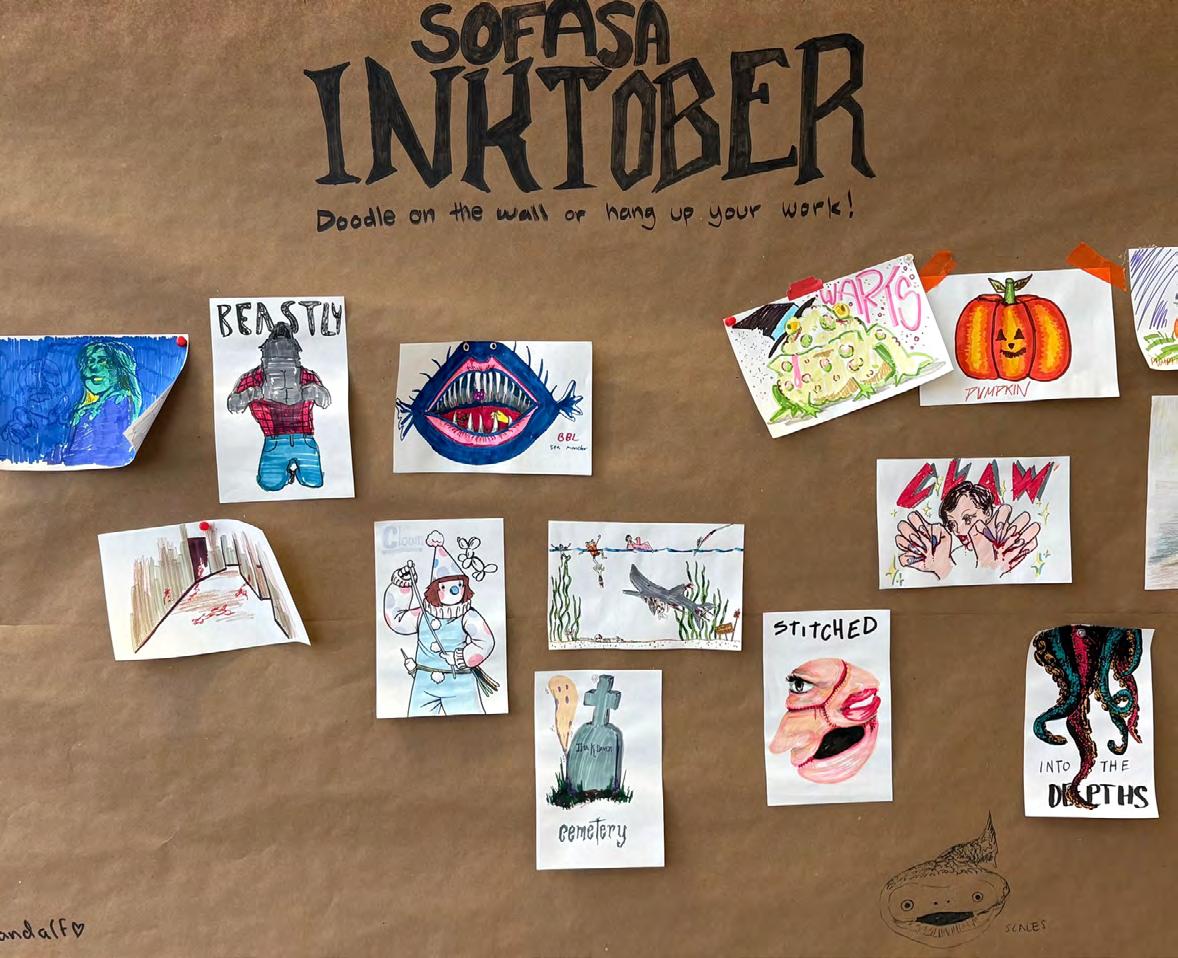
events such as potlucks, karaoke, movie screenings, group critiques and workshops.
SoFASA also hosted pumpkin-carving in the lounge during the same week, with many students taking home their creations. Recently, the school of art used the space to host quilt-
From Mars to the Manitoba prairie
Visit sofasa.org or follow SoFASA on Instagram @sofosa to learn about future events.
The Martian and the Mound — a collaborative effort in southern Manitoba
Mikaela Warkentin, staff
W hat makes a place worth remembering?
The Martian and the Mound explores memory and meaning with a science-fiction twist, all set against the backdrop of the Manitoba prairie. The play follows Dr. Phoenix Albright, an archeologist from Mars studying the unique draw a mound on the Manitoba prairie has, from ghosts across time to his own interest.
In every way, The Martian and the Mound is a love letter to the wide-open Manitoba prairies — of course, save for a singular, titular mound. A One Trunk Theatre production created alongside CandleWick Productions, a rural Manitoba prairies-based performing arts company, The Martian and the Mound also is a part of Theatre Projects Manitoba’s Live Art Trade Route initiative. The initiative stems from a desire to expand and enrich access to the arts throughout Manitoba, particularly within rural communities.
Travelling through southern Manitoba, the play’s opening night took place in the loft of the residence of Margruite and Paul Krahn, a Mennonite barn converted into a house and event venue. Both Krahns
are involved in the production of The Martian and the Mound, with Margruite serving as set, prop and video designer and Paul as a set builder and playing the role of Bison. From there, The Martian and the Mound headed 45 minutes west to the Kenmor Theatre in Morden, home of CandleWick Productions, which is headed by executive director Richard Klassen. Klassen also served as rehearsal director and performed onstage as the elder version of protagonist Dr. Phoenix Albright and shared with the Manitoban exactly how this travelling production came to be.
“One Trunk [Theatre] was doing workshops and they called us up […] with the theater here in Morden to see if we wanted to do some workshops with them,” shared Klassen. “We started with the workshops, and all of the sudden got a call, ‘Yep, we’re working on a script, could [One Trunk Theatre] come and read it with us?’”
For Paul Bergman and Andew Braun, who both served on a team of the production’s creators and are joint composers and sound designers for The Martian and the Mound, being a part of the production since its incep-
tion and watching it grow has been “pretty special.” Bergman shared that through the process, he and Braun have been “just trying to keep our heads down and pay attention to what we’re doing, but obviously peeking an eye at [the production] and seeing it all come together.”
Director and co-creator Gwendolyn Collins’ words resonated with Bergman, and he shared Collins’ sentiment of the relationships forged in this production. “Collins’ emphasis on process and relationships, that’s actually been quite true, because the play has been fun […] Such great people to work with, including Andrew.”
For Logan Addison, who portrayed Bruce, the production hit close to home. “I feel very privileged to tell a story that’s so based in our history in southern Manitoba,” Addison shared. “There’s not a whole lot of shows that are based [here].” Hailing from Morden himself, Addison is a current U of M theatre student. His character, Bruce, represents a real-life Morden icon, Bruce the Mosasaur, a near-complete skeleton of a Tylosaurus pembinensis discovered in the region in 1974. This isn’t the only reference

to southern Manitoba, however. “There’s a lot of jokes about the prairies,” shared Addison. “It just warms my heart, because I understand the jokes.”
One such element of the play was the dynamic between settlers of the area — portrayed as a race on stage. Vance Harrison Roberts, who portrays Sage, shared that the scene was a highlight for him. “It’s a play on the whole […] land discovery race that the settlers had during those times,” shared Roberts. “There’s a lot of […] jokes and little script moments that play really well in that scene, and I really enjoy it because of that.”
Taking this production from stage to stage has been a standout for cast and crew
alike, Roberts shared. “It’s been really interesting working with the different stage spaces, because in our first performance at the Krahn barn, it’s about half, maybe even […] 40 per cent of the stage space we have [at the Kenmor Theatre].” There were, however, benefits to the smaller space. “Because it was more of a compact area […] we could work with the lighting a lot better. [I] definitely enjoy having more space to work with, though.”
The Martian and the Mound is once again packing up and moving to another stage from Nov. 14 to 16, this time to the Gas Station Arts Centre in Winnipeg. To get tickets, visit theatreprojectsmanitoba.ca/ events.
ing workshops by Wally Dion, who has an ongoing show at the School of Art Gallery downstairs.
PHOTO BY JORDAN ANGLIN / STAFF
PHOTO PROVIDED BY ALEJANDRO PENNER
DR. PHOENIX ALBRIGHT (DEVIN LOWRY) AND THE ELDER DR. PHOENIX ALBRIGHT (RICHARD KLASSEN) MEET.
U of M takes part in International Cello Festival of Canada
Five-day cello extravaganza hosted on campus
Boris Tsun Hang Leung, staff
The third edition of the International Cello Festival of Canada was recently held in Winnipeg from Oct. 28 to Nov. 1. Several events took place in the Desautels Concert Hall and Eva Clare Hall at the U of M, in addition to other venues across the city.
One of the events on campus included The Bach Café, a concert series where each invited cellist performed one of Johann Sebastian Bach’s six suites for unaccompanied cello. The first of these suites contains one of the most wellknown cello pieces of all time — the G major prelude.
Apart from classical repertoire, cellists also joined forces with the Winnipeg Jazz Orchestra to perform classics such as George Gershwin’s “Rhapsody in Blue.”
The festival featured numerous world-renowned cellists
like the U.K.’s Colin Carr and Germany’s Alban Gerhardt. In addition to performing, the masters taught classes to budding cellists.
U of M faculty members also appeared in the festival’s concerts. Stephen Runge, a pianist, dean of the Desautels faculty of music and director of the school of art, performed a Ludwig van Beethoven sonata with cellist Inbal Segev. Minna Rose Chung, a professor of cello, also played in the festival’s Halloween concert.
One highlight was the performance of Bach’s fifth cello suite by Viennese cellist Matthias Bartolomey. Set in C minor and starting with the lowest possible note on the instrument, it is considered to have the darkest sound out of Bach’s cello suites. Rather than the stormy and gut-wrenching tone often associated with Bach’s fifth suite, Bartolomey’s interpret-
ation was surprisingly tender and introspective, often evoking wistfulness more than misery.
Bartolomey also appeared in A Halloween Special: Wood-Shredding Cellists on Oct. 31, a concert at St. John’s Anglican Cathedral that almost exclusively featured cellos. This program arranged beloved classical pieces such as Edvard Grieg’s “Morning Mood” for cellos, but also featured compositions by the performers.
The level of musicianship was astonishing, serenading the audience with rich timbres and taking them on a cello odyssey from Beethoven to the Beatles. The cellists concluded the Halloween special with a fiery tango composed by Astor Piazzolla performed on 12 cellos, earning a standing ovation.

Manitoban singer Desiree Dorion releases latest single
The
self-produced song, “Let Them,” is an ode to self-empowerment
Carrington Dong, staff
Originally from Manitoba, singer-songwriter Desiree Dorion has enjoyed a successful career in music, making her mark as a fourtime Manitoba Country Music Award winner.
When asked to describe her musical style, she said, “I’m a storyteller, first and foremost. I like to paint pictures with words and tell honest stories through song.”
In the last few years, Dorion has taken an interest in producing her own work.
Dorion’s first self-produced single, “Let Them,” was released on Sept. 12. The song was inspired by the end of a longtime friendship.
“I was initially really upset about it,” she recalled. “And then the more I got to thinking about the end of this friendship, the more I realized that the only person I can really control is myself, that if somebody doesn’t want to be in my corner, I just need to let them go […] let them be who they are, and I just have to continue being who I am. And that’s where my power lies.”
To reflect the song’s empowering message, Dorion decided to make the track upbeat with a “rockier” edge.
Dorion took an interest in music production after participating in Her 204, an album released through Women in
Music Canada where each artist was asked to record and, if they wished, produce a cover of a song by a woman artist. While working on that album, she learned how underrepresented women are among music producers — among all producers on the Billboard Hot 100, only a small fraction are women, a statistic she described as “abysmal.” So, when it came time to work on new projects, she had an idea.
“It dawned on me, ‘Well, why don’t [I] just produce it?’” she reflected. “I feel like I’m at the stage now in my career where […] I know how the whole process works.”
“Let Them” will be part of Dorion’s eighth studio album, which will be released in early 2026. The album will largely consist of revisited songs that were written some time ago.
“I have a bunch of songs in my catalogue that I haven’t ever shared with anybody,” she explained. “Some of them I’m touching up and I’m reworking, but some of them, I’m like, ‘Man, this is actually a good song […] people should hear this one.’”
In addition to a new album, Dorion has formed a band featuring three Indigenous musicians — drummer Michel Bruyere, bassist Leroy Constant and guitarist Troy Flamand. This came from a desire to continue advocating

for fellow Indigenous artists.
“I’ve held space in the advocacy world for Indigenous women and for Indigenous artists, and what I realized is that I […] was a bit of a hypocrite. I wasn’t hiring Indigenous people to work on my own music and to work on my own project. I thought, ‘Okay, well, that needs to change,’” she
said.
Dorion hopes that by getting involved in production, she might be able to inspire other young women to produce their own music.
“I really just hope that I can use my platform to inspire other female artists to […] take the reins and really own their project in the way that they
want to,” she stated.
Desiree Dorion’s latest single, “Let Them,” is now available on all major streaming platforms. For more information on Desiree Dorion, visit desireedorion.com or follow her on social media @desireedorion.
PHOTO BY BORIS TSUN HANG LEUNG / STAFF
PHOTO PROVIDED BY DAVE SWIEWICKI
Churchill band Days on Land launches debut album
Tales from the Shallows celebrates polar bear capital of the world
Boris Tsun Hang Leung, staff
The Churchill folkrock band Days on Land launched its debut album, Tales from the Shallows, on Oct. 24, releasing nine tracks that tell stories from the polar bear capital of the world.
Roy Mexted, singer-songwriter and bandleader, was born in New Zealand and raised in Australia. He travelled all over the world playing music in cafés and restaurants before settling in Churchill with his girlfriend.
Mexted explained that he had already been travelling in Canada for a year before landing a job in Churchill as a cook in 2017. However, what was meant to be the last leg of his Canadian adventure turned into something more permanent.
“The train line was actually washed out during that time, so there was no access by train. I had to be flown in, and all of the guests for that season were flown in,” he said. “The whole town had a sense of sorrow because their only lifeline to the rest of the world was gone, and it was gone for a year and a half. And that’s the time where I decided to stay in this town, when I felt the community spirit here, and I was welcomed, and I was able to give back to this community.”
That was when Mexted wrote his first song about the town, “When the Train Comes Back to Churchill,” which appears on his 2020 solo album, Smiling Like a Sundog
He later wrote a new album, this time bringing in local musicians to form Days on Land. The band currently consists of Joe Stover, Jeremi Lesage and Eric Robb in addition to Mexted. According to Mexted, “days on land” is a scientific phrase used to measure the health of polar bears.
“The more days on land they spend, the worse it is for them in the long run, the harder it is for them to survive […] It’s crucial that we keep an eye on that metric. So [the name of our band] speaks about the culture here, the importance of this place and of the polar bears,” he remarked.

Unsurprisingly, the songs in Tales from the Shallows prominently feature life in the north. Mexted emphasized that he wanted to tell stories that can only be experienced by living there and being a part of the community.
“Everybody who comes to Churchill is going to be taken to the Ithaka shipwreck and the Miss Piggy plane wreck, and they’ll go dog mushing, so these are the subjects that we pick up,” said Mexted. “We know the people who do the dog mushing. We know the history of the places here, so we write songs about them,
just to give people a soundtrack of their time here [and give them] something to take away.”
One of the tracks, “Bear 33,” is based on a true story of a rogue polar bear. Mexted pointed out that polar bears in Churchill used to be spraypainted with black numbers for identification, and Bear 33 was infamous for causing a commotion in town. The band has since posted a music video on YouTube with the band’s drummer, Eric Robb, dressed as Bear 33.
The band’s music can be described be as folk-rock due
to its commitment to storytelling. Mexted cited influences from John Williamson, an Australian country music star, The Tragically Hip and Stan Rogers. In addition to traditional instruments like the piano, accordion and harmonica, their songs feature more “hard-hitting” sounds from electric guitar and drums.
The band only came together last year, but they have already performed at the Harvest Moon Festival in Clearwater, Manitoba and are set to tour the province in May 2026 with shows in Churchill, Thompson, The Pas, Flin
Flon and possibly Winnipeg. The tour is also supported by imagiNorthern, a project that aims to amplify creative voices in northern Manitoba.
“We are […] very excited to hopefully go down to Winnipeg and play a couple of big shows down there to show people down south what we’ve got up here, up in the north,” Mexted concluded.
Tales from the Shallows is now available to stream on various platforms. Follow Days on Land on Facebook, Instagram, TikTok and YouTube @daysonland.

PHOTO PROVIDED BY DAYS ON LAND
Royal Manitoba Theatre Centre presents Life of Pi
Award-winning novel adaptation features deep storytelling and intricate puppetry
Carrington Dong, staff
T
he Royal Manitoba Theatre Centre has opened their 2025-26 season with the play Life of Pi Life of Pi was adapted from the award-winning novel of the same name by Yann Martel, which was also turned into an Academy Award-win ning film in 2012. The story follows Pi Patel, who, after losing everything in a disastrous shipwreck, spends 227 days on a lifeboat accompanied by a Bengal tiger. Pi is left to try and keep himself together while stranded at sea, all while hoping he does not become the tiger’s next meal.
Winnipeg-based artist and U of M alum Anaka Maharaj-Sandhu is one of the actors in the production. They were inspired to take up acting to follow in the footsteps of their older sister.
“[My sister] did stand-up comedy and she did plays here and there, and I just copied everything she did,” they reflected. “So, I immediately wanted to try acting, and then once I got into high school […] I realized that it was something I really enjoyed doing, and that’s when I started considering it as a career.”
Maharaj-Sandhu honed their craft by attending the National Theatre School of Canada, which they said was a great experience, noting that it was great for self-motivated performers such as themself.
“It was three years of fully focusing on my craft, which was […] a push that a lot of people need [in order] to take them from good to great,” they stated.
After graduating from NTS in 2022, Maharaj-Sandhu completed a bachelor of arts in political science at the U of M this fall. They had originally started their degree before attending NTS and resumed their studies afterwards, fitting classes and studying in between acting jobs. They expressed encouragement toward other aspiring actors to prioritize their education and seek any opportunities to better themselves and hone their craft.
In Life of Pi, Maharaj-Sandhu plays Rani, Pi’s older sister who is a soonto-be University of Toronto student, as well as a ghost version of Rani that appears later in the play. They also appear in the ensemble and are the understudy for the title role.
“[Rani] takes every opportunity to tease [Pi],” Maharaj-Sandhu said, with a laugh. “She’s very smart […] She’s very, very, very different from who I am as a person.”
To prepare for their role, Maharaj-Sandhu took a research-based approach, looking into their character’s background and hometown in Pondicherry (now Puducherry), India, and figuring out what Rani’s day-to-day would look like — including the music she would like and the books she would read.
“I was reading a lot of [economic] books to be like, ‘Hey, what the hell is math? I didn’t study math. What is this about? […] Why does she like this so much?’” they explained.
With a small cast and crew and many moving parts — most notably, an abundance of puppets — the experience had been somewhat unpredictable. However, this is something that Maharaj-Sandhu has enjoyed. One story stands out in particular, of a puppet breaking during the intermission.
“We were back from intermission and then all of a sudden, I’m like, ‘This is a really

long intermission, what the hell is going on?’ One of our puppets had broken, so they were taking the time to fix it,” they recalled.
Indeed, maintaining the puppets has been hard work, but worth it. The audience loved them, frequently asking questions about them during the post-show Q&As.
“I think that one of the parts of the show that could very easily fall flat […] are the puppets, if you have people who aren’t experienced [in puppetry] or puppets that don’t move as they should,” Maharaj-Sandhu remarked. “But people really love the puppets.”
When it comes to the show’s message, Maharaj-Sandhu
stated, “I think this is just such a beautiful example of what [it’s like] to undergo something extraordinary and tragic, and come out the other side still wanting to teach other people and share and come from a place of love and […] positivity.”
The Royal Manitoba Theatre Centre’s production of Life of Pi runs until Nov. 8 at the John Hirsch Mainstage. For tickets and information on upcoming productions, visit royalmtc.ca. For more information on Anaka Maharaj-Sandhu, visit their website anakasandhu.com or follow them on Instagram @ anakasandhu.

PHOTO PROVIDED
Back-to-back sweeps
Bisons dominate Calgary Dinos in 6-0 volleyball victory
Israel Adeogo Abejoye, staff
The Bisons men’s volleyball team showcased their prowess on the court, securing a 3-0 win over the University of Calgary Dinos on Thursday, Oct. 30. The team won the match with set scores of 25-18, 25-14 and 25-20.
The Bisons set the tone early in the first set, taking an early lead with three consecutive points, including a crucial ace from middle blocker Jonah Dueck. Despite the Dinos’ efforts, led by Cole Czepuryk’s kill, the Bisons maintained their momentum, trading points with their opponents before pulling away to win 25-18.
Bisons mens volleyball head coach Arnd Ludwig explained how his team was able to hold the Dinos down. “Our game plan was to serve strong, make sure that we get them a little bit out of system and then that we work with our blocking,” he said. “We exploited some things in our offense to make sure that we scouted them, where we see our offense can be successful and I think we did that very, very well today.”
inating performance by the Bisons, with Owen Weekes’ ace giving them an early advantage. The team continued to build on their lead, extending their margin to 9-4 and eventually cruising to a 25-14 victory.
In the third set, the Bisons got off to a strong start. They scored the first two points before Karil Dadash Adeh’s two aces helped them build a 6-1 lead. Although the Dinos attempted a comeback, the Bisons held firm, and scored four consecutive points to seal the win at 25-20.
The Bisons’ attack was led by 30 kills, outpacing the Dinos’ 25.
Ludwig explained how he intends to keep the momentum going for his team in the return match. “I think we had a not-so-good start in the season result-wise, so we are now
the game and make necessary adjustments for the rematch the next day.
Adeh mentioned how important the match was to him and his teammates. “For sure we needed it, because we had four losses in a row.” He added, “I don’t think anyone was super flashy today, but the entire team was super steady.”
Bisons sweep Dinos in rematch, extend winning streak
The Bisons men’s volleyball team dominated the Dinos once again, sweeping them 3-0 in the rematch on Friday, Oct. 31. The Bisons won the match with set scores of 25-17, 25-19 and 25-23, as they continued to showcase their strength and resilience on the court.
“I don’t think anyone was super flashy today, but the entire team was super steady” — Karil Dadash Adeh, Bisons mens volleyball right-side hitter
The second set was a dom-
1-4,” he stated. “I think the boys know what is [at] stake and we know that we have to come out tomorrow the same as we did today.” He added his team will watch the footage of
In the first set, the Dinos took an early lead, but the Bisons quickly regained control, scoring six consecutive points to take a commanding 14-7 advantage. Despite the Dinos’ efforts, the Bisons maintained momentum and won 25-17.
The second set followed a similar pattern, with the Bisons taking an early lead

thanks to Dueck’s kill. The Dinos attempted to mount a comeback, scoring four consecutive points to cut the margin to 19-15. However, the Bisons held firm, winning 25-19. The third set was a nailbiter, with the Dinos taking an early lead and maintaining it until coach Ludwig called a timeout. The Bisons responded strongly, tying the score at 11-11 and later at 20-20 after the Dinos had taken a 17-20 lead. The Bisons ultimately emerged victorious, winning 25-20.
Bisons football loses to the Regina Rams
The Rams defeated the Bisons 32-29 in the Canada West semifinals
The Bisons football team lost 32-29 to the University of Regina Rams in the Canada West semifinals game on Saturday, Nov. 1.
The Rams struck first, taking a 7-0 lead early in the first quarter after Marshall Erichsen’s 30-yard run at 14:06. The Bisons responded as Jackson Tachinski made a five-yard run at 9:51 to even the score at 7-7. The Rams regained the lead late in the quarter, forcing a team safety at 5:53 to go ahead 9-7.
In the second quarter, Noah Pelletier extended the Rams’ lead to 16-7 with a one-yard run at 11:30. Ty Gorniak added a 39-yard field goal for the Rams at 6:22 to make it 19-7. The Bisons responded late in the quarter, as Maya Turner kicked a 10-yard field goal at 2:44 to cut the gap to 19-10. Nathan Udoh caught a 26-yard pass from Tachinski at 0:53, bringing the Bisons within two points at 19-17 heading
into halftime.
At 3:34 in the third quarter, Gorniak kicked a 32-yard field goal to push the Rams’ lead to 22-17.
In the fourth quarter, the Bisons took the lead when Udoh caught a 32-yard pass from Tachinski at 7:45, making it 23-22. At 2:59, the Rams tied the game 23-23 with a rouge point from Isaac Wegner. At 0:33, Turner hit a 16-yard field goal to put the Bisons ahead 26-23. At 0:00, Gorniak answered with a 35-yard field goal for the Rams, sending the game into a 26-26 tie.
In overtime, Tuner kicked a 16-yard field goal to give the Bisons a 29-26 lead.
In overtime, Gorniak responded with a 22-yard field goal for the Rams, tying the game 29-29.
Gorniak sealed the win for the Rams in overtime with a 38-yard field goal, putting them ahead 32-29, a lead that remained as the final score.
With this win, the Bisons have now won six games in a row, demonstrating their dominance over the Dinos. Alex Witt said, “We’re always just trying to play one point at a time. So, trying to stay in it, trying to scramble well and put in some effort and see what happens. I think it was just a good team win today.”
The Bisons have now moved to the sixth position in the Canada West standings and will be facing the Brandon Bobcats on the road on Friday, Nov. 14 and Saturday, Nov. 15.

PHOTO PROVIDED BY ZACHARY PETERS
Abdul-Jalilu Ahmed, staff
PHOTO BY EBUNOLUWA AKINBO / STAFF
Bisons swept by Dinos in second game showdown
Bisons women’s volleyball’s loses 3–0 to Dinos in second game of the weekend
Faiyaz Chowdhury, staff
The Bisons women’s volleyball team faced the University of Calgary Dinos at the Investors Group Athletic Centre on Thursday, Oct. 30 and Friday, Oct. 31. They won the first game 3-1 (25-22, 21-25, 25-15, 25-21) before losing 3–0 in the rematch.
In game one of the weekend, the Bisons won with a better attacking efficiency which made the difference throughout the match. In set one, the herd took early control, edging the Dinos 25-22 and setting the tone with a potent attack (.444 hitting). The second set had the Dinos responding with renewed energy, which allowed them to win 25-21 despite the Bisons’ strong hitting (.348). The third set saw the Bisons dominate with a huge margin, posting a .700 hitting percentage and claiming a 25-15 victory, and in the fourth set, the herd maintained their momentum. There were less errors and they closed the contest 25-21. Raya Surinx for the Bisons was a clear standout with 18 kills.
In the second match, the Dinos flipped the script. Calgary won the match 3-0 (25–22, 25–19, 25–21). The Bisons tried to put on a strong show, but it was not enough to fend off the Dinos. Initially, the Dinos
were able to create a large gap, but the Bisons nearly caught up. However, in the end, the Dinos edged past to take the third and final set 25-22.
The second set saw the Dinos doing small flicks over the net, breaking the Bisons’ defence, but the herd was not giving up. The Bisons were able to get kills, and both teams were evenly matched in skill and points. Midway through the set, the Dinos were able to exploit the cracks in the Bisons’ defence, allowing them to edge ahead and finally win the set 25-19.
The third set witnessed the Dinos showing skillful defence that stopped the herd’s attacks while they continued finding gaps in the Bisons’ defence.
The Bisons tried many offencive attempts, but they were fended off by the Dinos’ blocks. The set ended with the Dinos winning 25-21.
Despite the loss, Eve Catojo and Surinx were both able to get 10 kills for the herd. Kalyssa Komori for the Dinos was able to get 14 kills with only one error. The Dinos and the Bisons were close when it came to kills, with 40 to 35, but when it came to block assists, the Dinos had 20 to the Bisons’ four.
Following the game, the Bisons women’s volley-
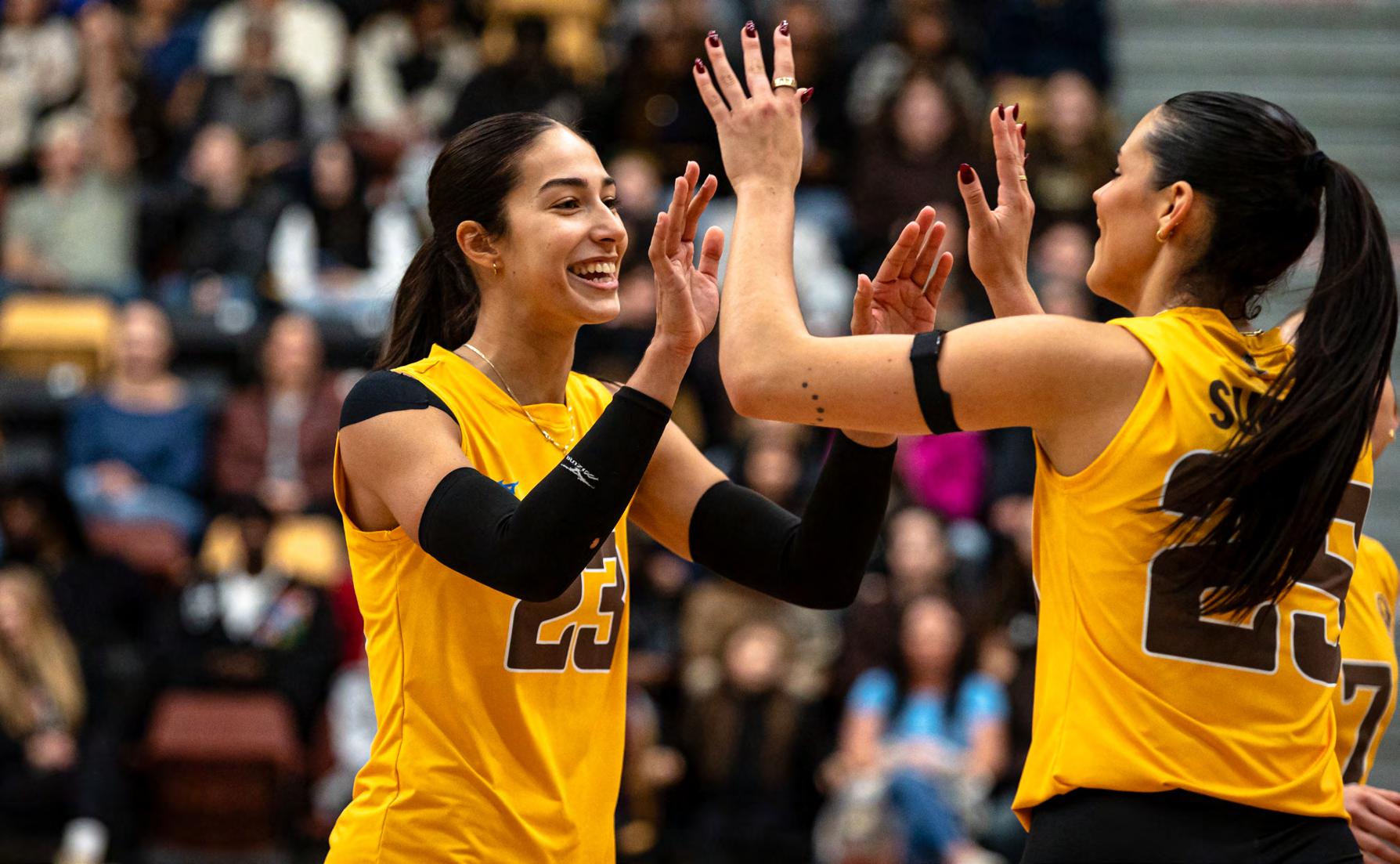
head coach Ken Bentley reflected on his team’s performance. He said, “[The Dinos] just flat out played better than us today. They competed harder, they played better defence, they pretty much beat us in every phase of the game today.”
When asked if any changes would be made for the next game, Bentley responded, “Each part of our game had to be better tonight than it was, obviously, we lost 3-0. The second leg’s always harder, we
certainly weren’t prepared for that by the looks of it.”
Reflecting further on the opponent team’s technical performance, Bentley said, “[The Dinos] blocked great today. We didn’t pass well, and they got a few blockers up on everything that we set, and they put it to us at the net for sure. They were the dominant team at the net today.”
The Bisons play the Brandon University Bobcats in two weeks. When asked about his expectations for
Bisons men’s basketball faces win and loss
that match, Bentley said, “We have a weekend off coming up, which is good for us, and we have two weeks to practice and get ready to go to Brandon and play better volleyball. So that’ll be our goal.”
The Bisons women’s volleyball team will face the Brandon Bobcats on Friday, Nov. 14 at 6 p.m. CT and Saturday, Nov. 15 at 5 p.m. CT in Brandon, Manitoba.
Bisons defeat Regina Cougars 78-62 in game one, lose 77-72 in game two
The Bisons men’s basketball team earned a 78-62 victory over the University of Regina Cougars on Friday, Oct. 31.
In the first quarter, Daren Watts opened the scoring for the Bisons with a jump shot at 9:20 for a 2-0 lead. The cougars gave a swift response as Kaz Dornstauder made a three-point jump shot at 9:08 to bring the score to 3-2. Watts later made a free throw at 6:05 to regain a 7-3 advantage for the Bisons. Tito Obasoto added two free throws for the Bisons at 1:50 to make the score 15-11, and with three seconds left, Taven Vigilance made a free throw to extend the Bisons’ lead to 21-13. At 8:13 in the second quarter, Bisons’ Ramogi Nyagudi made a three-point jump shot, assisted by Watts, widening their lead to 28-13. At 5:04, Nyagudi added another threepoint jump shot, with an assist from Mason Kraus, making it 31-19. Manyang Tong made a three-point jump shot at 2:49,
assisted by Kraus, to keep the Bisons ahead 36-24.
In the third quarter, Nyagudi made a dunk at 8:39, assisted by Watts, to push the Bisons’ lead to 40-30. Watts followed with a layup at 4:39, widening the lead to 50-35. Bisons Brandt Lenz made a jump shot at 1:03, making it 61-39. Isaiah Bay made a free throw for the Cougars at 0:30, bringing the score to 61-40.
At 3:14 of the fourth quarter, Bisons Jonam Kazadi made a free throw to give them a 70-50 lead. Entering the game with 1:34 remaining, Hudson Wollf made a layup at 0:30, extending the Bisons’ lead to 78-62, which stood as the final score.
In the second game on Saturday, Nov. 1, the Cougars defeated the Bisons 77-72.
The Bisons will open their home season against the University of Saskatchewan Huskies on Thursday, Nov. 6 at 8 p.m. CT and Friday, Nov. 7 at 8 p.m. CT at the Investors Group Athletic Centre.

ball
PHOTO PROVIDED BY ZACHARY PETERS
PHOTO PROVIDED BY BU BOBCATS
Abdul-Jalilu Ahmed, staff
